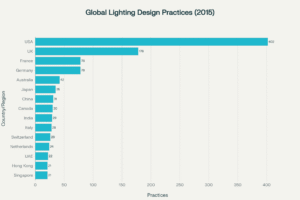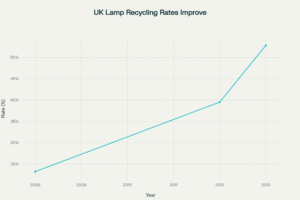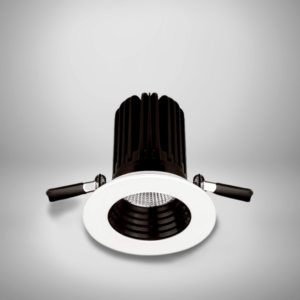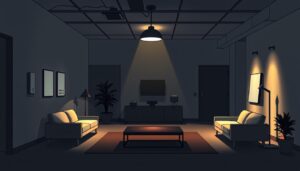Did you know bad office lighting can cut productivity by 15% and eye strain by 50%? People spend over 90,000 hours at work in their lives. So, getting your office lighting right is extremely important to get the most out of staff. That’s why we’ve created our office lighting calculator to help you make the right choice.
This tool makes it easy to design the perfect lighting for your office. It considers room size, ceiling height, and what tasks you do most. Our calculator gives you tailored advice to boost productivity, ease eye strain, and make your office a comfortable place to work.
Whether you’re setting up a new office or updating your lighting, our calculator makes it simple. No more harsh, poor lighting. Welcome to a bright, energising space that supports your team’s health and success.
UK Commercial Office Lighting Calculator
Welcome to your comprehensive guide for commercial office lighting in the UK. We'll help you design an effective lighting solution that enhances productivity, comfort, and energy efficiency.
Office Lighting Calculator
ROI Calculator
Key Considerations for Office Lighting
- General Lighting: Provides overall illumination for the entire office space.
- Task Lighting: Focused lighting for individual workstations to prevent eye strain.
- Accent Lighting: Highlights specific areas or objects for visual interest.
- Flexibility: Adaptable lighting for different tasks and user preferences.
- Energy Efficiency: Use of LED lighting and automatic controls to reduce energy consumption.
- Visual Comfort: Ensuring comfortable lighting without glare or excessive contrast.
- Integration with Daylight: Balancing natural and artificial light sources.
- Sustainability: Implementing efficient luminaires and control systems to increase building value.
- Technology and Flexibility: Using lighting management systems for optimum, need-based lighting control.
Recommended Illuminance Levels
| Area/Task | Illuminance (lux) |
|---|---|
| General office areas | 300-500 |
| Computer work | 300-500 |
| Filing, copying | 300 |
| Meeting rooms | 300-500 |
| Reception areas | 300 |
| Corridors | 100 |
The Importance of Proper Office Lighting
Good office lighting is key for employee well-being and productivity. It benefits both the individual and the company. By choosing the right commercial lighting, businesses can make their work environment better and healthier.
Research shows that proper lighting reduces eye strain, headaches, and tiredness. When workers can see well, they focus better and work more accurately. This means fewer mistakes, better quality work, and more productivity.
Good lighting also makes the office feel welcoming and looks better. It boosts morale, makes people feel good, and can spark creativity. By picking the right lights and planning the lighting, companies can make a space that employees enjoy coming to every day.
Some main benefits of good commercial lighting include:
- Improved visual acuity and reduced eye strain
- Enhanced mood and mental well-being
- Increased alertness and concentration
- Better color rendering and visual appeal
- Energy savings through efficient lighting technologies
Investing in good office lighting is good for employees and smart for business. It makes the workplace more productive, healthy, and engaging. As we look deeper into office lighting, we’ll find ways to improve lighting design for better results.
Understanding the Lumen Method
In the past, we often looked at the wattage (how much energy a light bulb uses) to determine how bright a light would be. But today, it’s more important to focus on lumens, which measure the brightness of the light.
Here’s why:
Efficiency: Newer lighting technologies, like LEDs, provide the same brightness (lumens) as older bulbs but use less energy (watts). For example, an LED bulb that uses 10 watts can produce the same brightness as a 60-watt incandescent bulb.
More accurate: While watts tell you how much energy a bulb consumes, lumens tell you how much light it gives off. So, for the same energy usage, a bulb with more lumens is brighter.
The lumen method is key in office lighting design. It helps figure out how much light a space needs. This ensures the area is both comfortable and productive.
In short, if you’re looking for a light that’s bright enough for a room, check the lumens, not the watts. It’s a better indicator of the lighting performance and energy efficiency.

Professional Lighting Level Assessment Tool
Evaluate your workspace lighting against CIBSE and industry-specific standards.
Lighting Assessment Calculator
CIBSE Recommended Illuminance Levels
| Area Type | Minimum (lux) | Standard (lux) | Optimal (lux) |
|---|
What Are Lumens?
Lumens measure how much light a source emits. The more lumens, the brighter the light. It’s different from watts, which measure energy use, not brightness. Some believe that they need to measure in watts because this is how it used to be done with traditional light sources and is still a persistent and mainstream misconception.
Knowing about lumens is vital for good office lighting. It lets designers create bright, energy-saving spaces.
Calculating Total Lumens Needed for a Room
To find out how many lumens a room needs, consider a few things. These include the room’s use, foot candle levels, and size.
Calculate total lumens by multiplying room size by foot candle level. For instance, a 200-square-foot office needing 50 foot candles would need:
200 square feet × 50 foot candles = 10,000 lumens
Getting the lumens right ensures the lighting is both enough and saves energy. This makes the work space more comfortable and productive.
Lumenloop's Office Lighting Calculator
At Lumenloop, we know how vital good lighting is for a productive and healthy office. Our office lighting calculator is here to help you get the lighting right. It’s a tool that makes planning and setting up your office lighting easy.
Key Features of the Calculator
Our calculator has special features for your office needs:
- Customisable inputs for office dimensions, ceiling height, and primary task types
- Accurate recommendations based on industry standards and best practices
- Consideration of both natural and artificial light sources
- Adjustable parameters for visual comfort and glare minimisation
- Integration with our energy-efficient LED lighting solutions
Benefits of Using the Office Lighting Calculator
Using our office brightness calculator brings many benefits:
| Benefit | Description |
|---|---|
| Time-saving | Streamline the lighting design process and avoid costly mistakes |
| Compliance | Ensure your office lighting meets industry standards and regulations |
| Productivity | Create a lighting environment that enhances employee performance and well-being |
| Customisation | Tailor your lighting plan to the specific requirements of your office space |
| Energy efficiency | Identify opportunities for energy savings and reduced environmental impact |
Our office lighting calculator removes the guesswork from designing your workspace lighting. It helps you make smart choices that focus on your employees’ health and your office’s efficiency.
Considering Office Size and Ceiling Height
When planning your office lighting, think about your workspace size and ceiling height. The size of your office affects the lighting you need. It helps create a bright space that boosts productivity and well-being.
Bigger offices with tall ceilings need stronger lights to light up every area. Smaller offices with lower ceilings might need lights placed carefully to avoid glare and shadows.
Our office lighting calculator helps with these challenges. It considers your office’s size and ceiling height. By entering these details, it suggests the best light levels for your office.
Here’s a table with guidelines for light levels based on office size and ceiling height:
| Office Size | Ceiling Height | Lumens per Square Foot |
|---|---|---|
| Small | 8 feet | 30-50 |
| Medium (150-300 sq. ft.) | 10 feet | 40-60 |
| Large (> 300 sq. ft.) | 12 feet | 50-70 |
By considering your office size and ceiling height, you can get the right lighting. This improves comfort and makes your office a better place to work.
Determining Primary Task Types and Lighting Needs
When designing office lighting, it’s key to think about the tasks done in each area. Tailor the light to match these needs. This way, you can make a space that’s both comfy and productive for your team.
General Office Areas
General office spaces need light between 300 and 500 lux. This level is good for reading, writing, and other common tasks. It helps avoid eye strain and keeps you focused.
Computer Work
Computer areas might need less light, about 300 lux. This helps cut down glare on screens and keeps your eyes comfortable. Using indirect light or task lamps can also reduce shadows and reflections.
Filing and Copying
Filing and copying areas should have light between 300 and 500 lux. This amount is perfect for reading documents and using office machines.
Meeting Rooms
Meeting rooms need flexible lighting for different activities. A light range of 300 to 500 lux works well. You can adjust the light as needed for presentations or discussions.
Reception Areas
Reception areas are the first thing visitors see. They should be welcoming and well-lit. Aim for 300 to 500 lux, using warm colours and smart light placement to create a friendly vibe.
Corridors
Corridors need less light, around 100 lux. This is enough for safe walking and saves energy. Using motion sensors or timers can help save even more by adjusting light levels when needed.
By matching office lighting to each area’s needs, you create a balanced and comfortable space. This supports the varied lighting needs of your organisation.
Balancing Natural and Artificial Light Sources
Creating a well-lit office is key for productivity and well-being. It’s important to mix natural and artificial light well. This way, you get the best of both worlds, keeping your space bright all day.
The Role of Natural Light in Office Spaces
Natural light makes offices healthier and more welcoming. It boosts mood, alertness, and helps our bodies keep to a natural day-night cycle. Plus, it cuts down on energy costs, saving money and the planet.
Strategies for Integrating Daylight
To bring more natural light into your office, try these tips:
- Translucent window treatments: Choose sheer curtains or blinds to soften sunlight and let in plenty of light.
- Light shelves: Place light shelves on windows to bounce sunlight further into the room, brightening it up.
- Workstation positioning: Put desks near windows to ensure everyone gets a good dose of natural light.
When using these strategies, think about your building’s layout, window size, and where each desk needs to be. The table below helps you get the most natural light based on your office’s direction:
| Office Orientation | Daylight Integration Strategy |
|---|---|
| North-facing | Make windows bigger to get soft, consistent light |
| South-facing | Use light shelves and shades to control the sun’s direct rays |
| East-facing | Go for translucent windows to soften the morning sun |
| West-facing | Install blinds that can be adjusted to block afternoon glare |
By mixing natural and artificial light and using smart daylight strategies, you can make a space that’s good for everyone. It will be bright, healthy, and energy-efficient.
Ensuring Visual Comfort and Minimising Glare
Creating a visually comfortable office is key for employee productivity and well-being. Too much glare and contrast can cause eye strain and headaches. This can affect job satisfaction and performance. To improve workspace lighting, it’s important to reduce glare and ensure even lighting.
Using diffused lighting is a good way to cut down glare. Fixtures that spread light evenly across the workspace help avoid harsh shadows and bright spots. Techniques like uplighting or using light-diffusing materials can also make the light softer and more comfortable.
It’s also important to place light sources correctly to avoid glare on computer screens and work surfaces. Task lighting should be on the side of the workstation, not in front or behind. Adjustable desk lamps with dimming options let people adjust the light to their liking.
When picking light fixtures, look at their Unified Glare Rating (UGR) values. The UGR shows how likely a light is to cause glare, with lower values meaning less glare. Here are some recommended UGR values for different office areas:
| Office Space | Recommended UGR Value |
|---|---|
| Open-plan offices | 19 |
| Private offices | 16 |
| Meeting rooms | 19 |
| Reception areas | 22 |
| Corridors | 25 |
Following these guidelines and choosing fixtures with the right UGR values helps ensure good lighting. This not only makes the office look better but also improves employee health and happiness. It creates a more productive and satisfying work environment.
Choosing Energy-Efficient LED Lighting Solutions
LED lighting is the best choice for a green and energy-saving office. It cuts down on carbon emissions and offers better light quality. Plus, it saves money in the long run. By choosing energy-efficient lighting, you make your office better for work and the planet.
Advantages of LED Office Lighting
LED lighting has many benefits for offices, including:
- It uses up to 75% less energy than old bulbs
- It lasts up to 50,000 hours, saving on repairs
- It turns on instantly, giving you bright light right away
- It shows colours well, making your space more comfortable
- It shines light where you need it, saving energy
- It doesn’t get hot, making your office cooler
Selecting the Right LED Fixtures
When picking LED lights for your office, think about these points for the best results:
| Factor | Description | Recommended Range |
|---|---|---|
| Colour Temperature | The warmth or coolness of the light | 3500K-5000K for offices |
| Colour Rendering Index (CRI) | How well the light shows colours | 80 or higher for offices |
| Lumens per Watt (Efficacy) | How much light you get per watt of power | 100 lm/W or higher for energy saving |
| Glare Control | Features that reduce glare and improve comfort | Diffusers, lenses, or indirect lighting |
Choosing the right LED lights means you get great light without wasting energy. Lumenloop’s office lighting calculator helps you find the best LED options for your space. This way, you can reach your green goals while making your office better.
Implementing Flexible Lighting Control Systems
In today’s fast-changing office settings, flexible lighting control systems are key for saving energy and making employees comfortable. By using the latest office lighting control tech, companies can make workspaces that change with the day’s needs.
Adjusting light levels for different tasks and personal tastes is a big part of workspace illumination flexibility. Dimming controls let workers adjust their light, cutting down eye strain and boosting health. Also, zoning lets you focus light where it’s needed, saving energy in empty spaces.
Commercial lighting automation goes further by adding sensors and daylight tech. Sensors turn lights on and off based on who’s there, saving lots of energy. Daylight tech uses natural light to help out, cutting down on artificial light use. Try the office illumination estimator part of the calculator to learn how how many luminaires are required.
When setting up flexible lighting systems, think about these features and their benefits:
- Dimming controls for personal light settings
- Zoning for precise light use
- Occupancy sensors for energy saving
- Daylight harvesting for natural light use
- Integration with building systems for easy control
| Lighting Control Feature | Benefits |
|---|---|
| Dimming Controls | Personalised lighting levels, reduced eye strain |
| Zoning Capabilities | Targeted illumination, minimised energy waste |
| Occupancy Sensors | Automated energy savings, lights only on when needed |
| Daylight Harvesting | Optimised use of natural light, reduced energy consumption |
By using office lighting control systems and focusing on workspace illumination flexibility, companies can make better, greener workspaces. These spaces support health and work well, saving money and showing a green commitment.
Enhancing Productivity and Well-being with Proper Lighting
The lighting in your office is key to a productive and healthy work space. The right office lighting productivity strategies help create a focused and comfortable area. This reduces eye strain and boosts employee well-being.
Studies show that workspace illumination well-being affects employee performance. Optimal lighting improves concentration, reduces fatigue, and boosts job satisfaction. This leads to higher productivity and better results for your organisation.
The Impact of Lighting on Employee Performance
To get the most from commercial lighting comfort, consider a few important factors:
- Illumination levels: Make sure each area has the right amount of light for the tasks.
- Colour temperature: Pick light sources that keep you alert and reduce eye strain.
- Glare control: Minimise glare from windows and artificial lights.
By focusing on these, you can make a lighting environment that supports employee well-being. This helps them perform at their best.
Creating a Comfortable Work Environment
Optimising lighting for productivity is just the start. Creating a comfortable work environment is also key. Here are some strategies:
| Strategy | Benefit |
|---|---|
| Incorporate natural light | Improves mood and reduces eye strain |
| Provide individual lighting control | Allows employees to adjust lighting to their preferences |
| Use biophilic design elements | Promotes a connection to nature and reduces stress |
By making your work environment comfortable and visually appealing, you support your employees’ physical and mental health. This leads to higher job satisfaction and productivity.
Utilising the ROI Calculator for Cost Savings
Thinking about upgrading your office lighting? It’s very useful to estimate the return on investment (ROI) and long-term savings. At Lumenloop, we offer a simple ROI Calculator. It helps you see the financial gains of switching to energy-saving LED lights for your office.
Understanding the ROI Calculator
Our ROI Calculator gives a clear picture of the savings and payback time for your lighting upgrade. Just enter details like the number of fixtures, wattage, daily use, and electricity costs. It then shows you the energy savings and cost cuts from LED lighting.
The calculator looks at many parts of your lighting setup, including:
- Current lighting technology (e.g., fluorescent, incandescent)
- Number of fixtures and their wattage
- Daily usage hours
- Electricity costs per kilowatt-hour (kWh)
Assessing Energy Efficiency and Cost Savings
Using the ROI Calculator, you can see how much energy and money you’ll save with LED lights. It breaks down the savings into clear parts, like:
| Metric | Description |
|---|---|
| Annual Energy Savings | The estimated reduction in energy consumption (kWh) and costs per year |
| Payback Period | The estimated time it will take for the cost savings to offset the initial investment |
| 10-Year Cost Savings | The projected total cost savings over a 10-year period |
| CO2 Emissions Reduction | The estimated decrease in carbon dioxide emissions due to improved energy efficiency |
Knowing the long-term financial and environmental benefits of LED lighting helps you make smart choices. The ROI Calculator lets you improve your commercial lighting and save money. It also helps reduce your carbon footprint.
Best Practices for Office Lighting Design
Creating a good office lighting plan is all about balance. You need to think about comfort, productivity, and saving energy. By using office lighting best practices, you can make a space that’s bright and works well for everyone.
First, measure your space carefully. Look at its size, layout, and what people do there. Use our office lighting calculator to figure out how much light you need. Remember to think about the height of your ceiling and what tasks are done in each area.
For a great lighting plan, mix ambient, task, and accent lighting. Ambient lighting lights up the whole room. Task lighting focuses on where people work. Accent lighting adds special touches or highlights important parts of the room.
Choose the right colours and how well they show details for your lights. Here’s a simple guide for different parts of your office:
| Area | Colour Temperature | CRI |
|---|---|---|
| General Office | 3500-4000K | 80+ |
| Computer Work | 4000-5000K | 80+ |
| Meeting Rooms | 3000-4000K | 90+ |
| Reception Areas | 2700-3500K | 90+ |
Make your lighting flexible and easy to control. Use dimmers, sensors, and daylight to save energy. Let people adjust the light to fit their needs and tasks.
By following these tips and using our calculator, you can make a lighting plan that’s good for everyone. It will make your workspace more comfortable, productive, and green.
The Future of Office Lighting Technology
Looking ahead, the future of office lighting is full of promise. New technologies will change how we light our workspaces. This will bring a new era of innovative workspace illumination.
Expect human-centric lighting that follows our natural rhythms. Also, smart systems will connect with the Internet of Things (IoT) and create whole new ecosystems of compatible products. With the advent of Matter, we’re already beginning to see this standardization across the industry.
Personalised task lighting is a big step forward in future office lighting. Imagine lights that adjust to your needs and tasks. This tighter, more granular control creates the perfect environment for work and health.
Advanced commercial lighting solutions will learn and adapt to each person. This ensures a lighting experience that’s both comfortable and reduces eye strain.
Biophilic design is another exciting area in innovative workspace illumination. It brings nature into our workspaces. This includes natural light, green walls, and organic shapes.
Research shows it boosts mood and cognitive function. It also lowers stress. This leads to happier and more productive employees.
The circular economy will also shape office lighting. We’ll see modular, upgradable fixtures. This means our workspaces can grow and change without harming the environment.
Frequently Asked Questions about Office Lighting
Many questions come up about office lighting. What are the best practices and technologies for a well-lit workspace? We’ll answer some common office lighting FAQs to guide you in choosing the right commercial lighting.
One big question is about lumens and lux. Lumens show how much light a source gives off. Lux measures how much light hits a surface. It’s key to use both when setting up your office lights for good lighting.
Colour temperature is another big topic. Here’s a table showing colour temperatures and their effects:
| Colour Temperature | Kelvin Range | Application |
|---|---|---|
| Warm White | 2700K – 3500K | Relaxing, inviting spaces |
| Cool White | 3500K – 5000K | Productive, focused environments |
| Daylight | 5000K – 6500K | Vibrant, energising areas |
When picking LED lights, look at the colour rendering index (CRI). A high CRI (80+) means colours look better and are more comfortable to look at. This is great for tasks that need colour accuracy.
For more help on office lighting design, check out our other resources or contact us for a customized proposal. We’re ready to help you choose the best commercial lighting for a productive and healthy workspace.
Conclusion
Optimising office lighting is key for a productive and comfy work space. Our office lighting calculator helps you make smart choices. These choices support your team and your business’s growth.
Investing in good commercial lighting saves energy and boosts comfort. It also makes your office more flexible. This leads to many benefits for your work environment.
When planning office lighting, think about room size, ceiling height, and task types. Balance natural and artificial light well. Use the lumen method to get the right amount of light.
Choosing energy-saving LED lights and flexible control systems is smart. They make your lighting better and more sustainable.
Good office lighting saves energy and cuts costs. It also improves employee health and work performance. Stay updated with office lighting trends to create a great work space.
Well-designed lighting makes your office look good and feel comfortable. It meets your organisation’s specific needs. Enjoy the many advantages of good office lighting in your workspace.
FAQ
What factors should I consider when calculating the lighting requirements for my office?
When figuring out your office’s lighting needs, think about a few things. The space’s size, ceiling height, and the tasks done there matter. Our lighting calculator considers these to give you the best advice for your office.
How can proper office lighting impact employee productivity and well-being?
Good lighting in the office is key for a comfy and productive space. It helps you focus, cuts down eye strain, and boosts job happiness. A well-thought-out lighting system supports your team’s health and work performance.
What are the benefits of using LED lighting solutions in office spaces?
LED lights are great for offices because they save energy and last long. They also need less upkeep and offer good colour and adjustable brightness. This lets you tailor your workspace for comfort and style.
How can I incorporate natural light into my office lighting design?
Adding natural light to your office boosts well-being and cuts energy use. Use clear window treatments, light shelves, and place desks near windows. But, make sure to balance natural and artificial light for even lighting all day.
What are the recommended illuminance levels for different areas within an office?
Every part of the office needs different light levels. General areas need 300-500 lux, while computer spots might be a bit lower to avoid glare. Meeting rooms, reception, and corridors also have specific needs, from 100-500 lux.
How can I ensure visual comfort and minimise glare in my office?
To avoid glare and ensure comfort, use soft lighting and place lights right to avoid direct glare. Choose fixtures with good UGR values. Flexible lighting systems, like dimming, help adjust to changing needs.
What is the lumen method, and how is it used in office lighting calculations?
The lumen method is a common way to figure out lighting needs. It looks at lumens needed for the right light levels, based on room size, tasks, and reflectances. Our calculator uses this method for precise advice for your space.
How can I assess the cost savings and energy efficiency of upgrading to LED office lighting?
Our ROI Calculator helps you see the savings and energy benefits of LED lighting. Just enter your current setup and costs, and it shows the savings and payback time. This helps you decide on upgrading your lighting.












